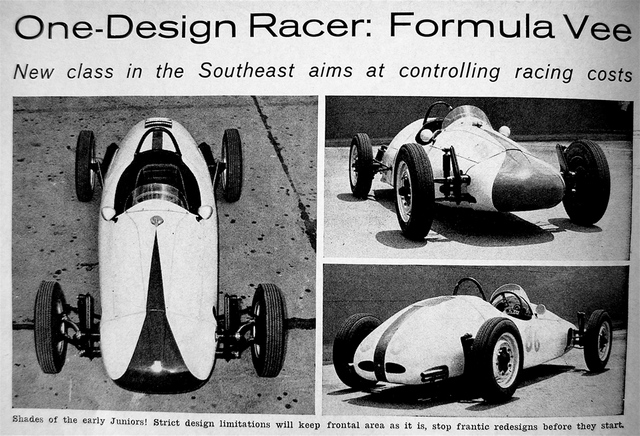HOME Getting
Started in Formula Vee
Links Page |
| The OLD Fred Storer in his handsome 1963 FormCar |
And .. The NEW Stevan Davis's new 2008 'Bullet' |
Formula Vee has its foundations starting in ~1959 or so. SCCA first recognized it as a class in 1963. Since that time, it has not only survived, but become the most prolific single seat race car in the world! Much has been written so I will attempt to link to as much info as possible, but still record it specifically on this site as well. This is an effort to ensure that the information is preserved - while still giving credit to the original authors. The links below are both for this site and the original location where information has been 'lifted'.
|
Vee Lines from the original FV
Association For a genuine look into the birth history of United States SCCA FV, read through these issues of 'Vee Lines', the first publication of the fledging Formula Vee Association in 1964. If you wonder how and why the rules came to be what they are today, this will be a great read for you! |
The Nardi - the 'concept car' for Formula Vee
This history is from Alan Harding Services in Europe. I don't know Alan, but found this information via websearch. I also don't know the origin or accuracy of the information, but his History pages fill in many of the missing holes from our local page on the Nardi above.
Road and Track Magazine printed several articles about Formula Vee.
We have reproduced 2 of them here. If you have copies (hard or computer) of
other early print articles, please contact the webmaster (link below).
R&T Articles.
A VERY interesting picture and article from the early (and WILD) days of Formula Vee - 1967 @ Monaco
Car and Driver also had an article or 2. This one is from June 1965 by Brock Yates (Quote: "Mark my words, Formula Vee competition is going to be around for a long while, because it just may be the best amateur racing class ever devised" ... I think he was right! <G>).
Hot Rod Magazine produced a Volkswagen Handbook in 1963 that included several pages specifically about Formula Vee. You can see them HERE.
forums.Autosport.com has a thread about Formula Vee back in the 60's that is interesting. I have reproduced part of it here incase the thread gets erased at some point.
An early article for FV (origin unknown)

Formula Vee is a single-seat junior racing league that was governed by strict
racing rules creating some of the most competitive racing of all time. In
comparison to other racing leagues, Formula Vee (FV) is low-cost. The buy-in was
around $2000 with a competitive machine costing just over $5000. In modern times
the price has increased to around $15,000 - $20,000 for a competitive racer. In
comparison to other racing leagues, this is still very low. Throughout the
years, the rules have changed to lower the costs, improve performance, or to
allow for the substitution of parts as many have since been discontinued. Since
the playing field is relatively even in terms of mechanical components and
capabilities, drivers must heavily rely on their skill and technique in order to
emerge victorious.
Formula Vee traces its history back to 1960 and was started at the request of
Volkswagen dealers. Three years later, the league was established and recognized
as a class within SCCA (Sports Car Club of America).
These mid-engines cars were limited to a 1200cc engine, gearbox and suspension -
all courtesy of the Volkswagen Beetle. Air restrictors may be used to keep the
power similar for all drivers. The transmission is a VW Type 1 four-speed
gearbox along with a set of VW ratios. The body is fiberglass and the chassis is
a tube frame. The chassis are known for their low-cost and easy repair and high
structural integrity, allowing most drivers to walk away from accidents. Dunlop
produces a tire specifically for Formula Vee and this is the only tire allowed
in the sport. The tire is suitable in wet or dry racing conditions. Wings are
not allowed. Limited slip differentials or any type of traction-control is
prohibited. The 1040 pound racer is capable of speeds up to 120 mph.
Some of the more renowned producers of these historic racers are Zink,
Autodynamics, Lynx, and Formcar. The cars are no longer produced but aftermarket
parts are still available.
In the sport of FV, the best driver wins.